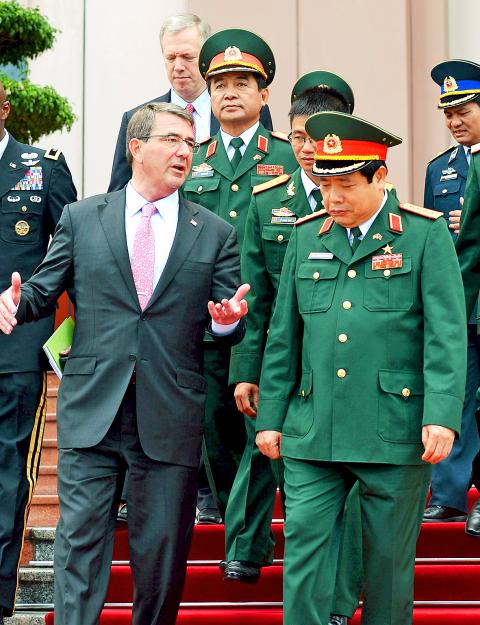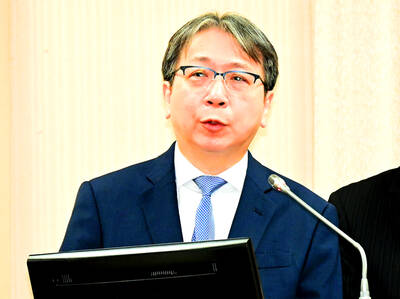A Vietnamese military band yesterday performed a rousing Star Spangled Banner as US Secretary of Defense Ashton Carter arrived for talks at the Ministry of Defense in Hanoi.
Once inconceivable, such displays between the wartime adversaries are increasingly common as Vietnam frets over China.
Carter and his counterpart, Vietnamese Minister of Defense Phung Quang Thanh, later signed a “joint vision statement” pledging to expand defense trade — including possible coproduction — and collaborate on maritime security.

Photo: Reuters
“We are both committed to deepening our defense relationship,” Carter said. “We had a very in-depth discussion that extended well over an hour-and-a-half because there is so much we are doing together.”
Carter’s Vietnam stop, midway through a 10-day Asian swing, was a signal to China that its South China Sea island-building campaign is alienating its neighbors. However, the first visit to Hanoi by a US defense secretary since 2012 was also a reminder of the limits of the burgeoning US-Vietnam relationship.
The new vision statement, which builds on an accord from 2011, is not legally binding. New US arms sales have been slow to develop since the administration of US President Barack Obama last fall partially lifted a long-standing ban on military sales to Vietnam. Hanoi has reportedly been baffled by Pentagon procedures.
In Washington, expanded arms sales are opposed by Human Rights Watch, which said Vietnam’s rights record “remains weak in all key areas.”
Some older members of the Vietnamese politburo, who recall the US as the enemy, are skeptical of a complete turnabout, and while Vietnam is wary of Chinese domination, China remains its top trading partner and an important source of capital.
“This is a piece of complex systems engineering,” said Dean Cheng (成斌), an Asian affairs specialist at the Heritage Foundation in Washington. “There are many, many moving parts, not just China and the US. The whole area is very much in flux.”
With 42 percent of Vietnamese no more than 24 years old, wartime memories are overshadowed by contemporary worries about China.
Still, Vietnam’s US$90 billion in two-way trade with China is more than double its annual cross-border commerce with the US, and more than 10 percent of foreign investment in Vietnam comes from Chinese companies.

The US government has signed defense cooperation agreements with Japan and the Philippines to boost the deterrence capabilities of countries in the first island chain, a report by the National Security Bureau (NSB) showed. The main countries on the first island chain include the two nations and Taiwan. The bureau is to present the report at a meeting of the legislature’s Foreign Affairs and National Defense Committee tomorrow. The US military has deployed Typhon missile systems to Japan’s Yamaguchi Prefecture and Zambales province in the Philippines during their joint military exercises. It has also installed NMESIS anti-ship systems in Japan’s Okinawa

TRAGEDY STRIKES TAIPEI: The suspect died after falling off a building after he threw smoke grenades into Taipei Main Station and went on a killing spree in Zhongshan A 27-year-old suspect allegedly threw smoke grenades in Taipei Main Station and then proceeded to Zhongshan MRT Station in a random killing spree that resulted in the death of the suspect and two other civilians, and seven injured, including one in critical condition, as of press time last night. The suspect, identified as a man surnamed Chang Wen (張文), allegedly began the attack at Taipei Main Station, the Taipei Fire Department said, adding that it received a report at 5:24pm that smoke grenades had been thrown in the station. One man in his 50s was rushed to hospital after a cardiac arrest

ON ALERT: Taiwan’s partners would issue warnings if China attempted to use Interpol to target Taiwanese, and the global body has mechanisms to prevent it, an official said China has stationed two to four people specializing in Taiwan affairs at its embassies in several democratic countries to monitor and harass Taiwanese, actions that the host nations would not tolerate, National Security Bureau (NSB) Director-General Tsai Ming-yen (蔡明彥) said yesterday. Tsai made the comments at a meeting of the legislature’s Foreign Affairs and National Defense Committee, which asked him and Minister of National Defense Wellington Koo (顧立雄) to report on potential conflicts in the Taiwan Strait and military preparedness. Democratic Progressive Party (DPP) Legislator Michelle Lin (林楚茵) expressed concern that Beijing has posted personnel from China’s Taiwan Affairs Office to its

PUBLIC SAFETY: The premier said that security would be tightened in transport hubs, while President Lai commended the public for their bravery The government is to deploy more police, including rapid response units, in crowded public areas to ensure a swift response to any threats, President William Lai (賴清德) said yesterday after a knife attack killed three people and injured 11 in Taipei the previous day. Lai made the remarks following a briefing by the National Police Agency on the progress of the investigation, saying that the attack underscored the importance of cooperation in public security between the central and local governments. The attack unfolded in the early evening on Friday around Taipei Main Station’s M7 exit and later near the Taipei MRT’s Zhongshan